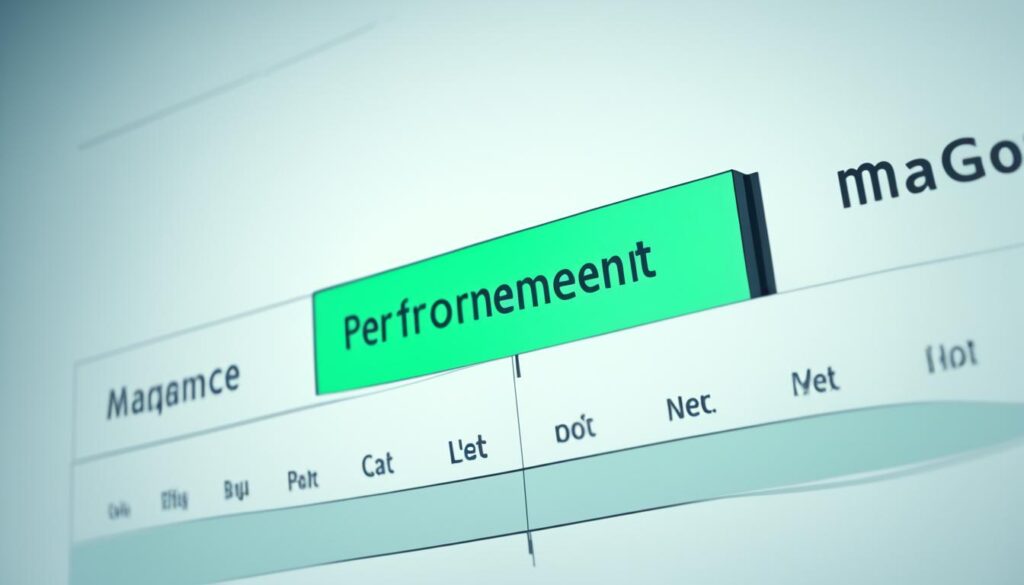Achieve Your Performance Management Goal Today

Are you struggling to set and track your performance management goals effectively? Do you find it challenging to align your goals with your organization’s strategic plan? The key to success lies in understanding the importance of goal setting and tracking in performance management.
Goal-setting is more than just a series of tasks or objectives. It provides direction, focus, and purpose for individuals and teams. It helps organizations align their resources and efforts towards a common purpose, driving them towards success. When it comes to performance management, setting meaningful and achievable goals is crucial for driving performance and achieving desired outcomes.
So, how can you effectively set and track performance management goals to ensure you’re on the path to success? How can you overcome common challenges and maximize your performance targets? In this article, we will explore the different perspectives of performance management goals and provide you with actionable strategies to achieve your goals effectively. Let’s dive in!
Key Takeaways:
- Setting clear and specific goals is crucial for effective performance management.
- Aligning performance goals with the organization’s strategic plan is essential for success.
- Tracking progress and providing regular feedback helps improve performance.
- Performance management goals can be categorized into financial, customer, internal process, and learning and growth perspectives.
- By implementing best practices and strategies, organizations can optimize their performance management efforts and achieve desired outcomes.
Performance Management Goals for Financial Perspective
Setting financial goals is crucial for the success of for-profit organizations. When it comes to performance management, having clear objectives in the financial perspective is essential. By setting specific goals, organizations can drive their financial performance, increase revenue, decrease costs, and ultimately maximize profits.
Here are some examples of performance management goals for the financial perspective:
- Increase revenue: Organizations can set targets to boost sales and expand their customer base. This can be achieved through effective marketing strategies, product innovation, or entering new markets.
- Decrease costs: To improve profitability, organizations should identify areas where costs can be reduced. This may involve streamlining operations, optimizing supply chain management, or implementing cost-saving technologies.
- Increase profits: Ultimately, the goal of any business is to generate profit. Organizations can focus on increasing their profit margins by improving operational efficiency, enhancing pricing strategies, or diversifying revenue streams.
Tracking these financial performance goals requires the use of Key Performance Indicators (KPIs). These metrics provide measurable insights into the organization’s progress. Here are some KPIs that can be used to measure financial goals:
- Revenue in target markets: This KPI tracks the organization’s performance in specific markets or segments.
- Operating costs: Monitoring operating costs helps identify areas of inefficiency and enables cost reduction strategies.
- Net profit: This KPI measures the organization’s bottom line and is a key indicator of financial success.
By setting clear financial goals and effectively tracking them using relevant KPIs, organizations can improve their financial performance, increase revenue, decrease costs, and ultimately increase profits.
Performance Management Goals for Customer Perspective
Customer satisfaction plays a significant role in the strategic success of any organization. When it comes to the customer perspective of performance management goals, the focus is on improving customer perception, enhancing the customer experience, and ensuring the safety and security of the community.
Improving customer perception involves shaping how customers view your brand and overall reputation. By consistently delivering high-quality products and services, addressing customer feedback promptly, and building strong relationships, you can positively influence customer perception. This, in turn, can lead to increased customer loyalty, positive word-of-mouth, and improved market perception.
To improve the customer experience, organizations should focus on enhancing every touchpoint of the customer journey. This includes streamlining processes, providing personalized and responsive customer support, and leveraging technology to deliver seamless interactions. By prioritizing the customer experience, organizations can foster customer loyalty, drive repeat business, and strengthen their competitive advantage.
For local governments, ensuring the safety and security of the community becomes a critical performance management goal. This can involve implementing effective crime prevention strategies, promoting community engagement, and addressing public concerns promptly. By prioritizing community safety, local governments can improve their market perception and foster a sense of trust and well-being among residents.
Key Performance Indicators (KPIs)
Measuring progress towards these performance management goals requires the use of Key Performance Indicators (KPIs). Key KPIs for the customer perspective can include:
- Market share index: This metric measures your organization’s market presence and the share of the market you occupy compared to your competitors. A higher market share index indicates a stronger position and positive customer perception.
- Customer satisfaction: This KPI measures how satisfied your customers are with your products, services, and overall experience. Regular customer satisfaction surveys, feedback mechanisms, and customer retention rates are essential for tracking this metric.
- Crime rate: For local governments focused on community safety, the crime rate serves as a key indicator. Tracking crime rates, analyzing trends, and implementing effective crime prevention initiatives can help improve the safety and security of the community.
By setting performance management goals aligned with the customer perspective and measuring progress through relevant KPIs, organizations can proactively improve customer perception, enhance the customer experience, and strengthen their market perception.

Performance Management Goals for Internal Process Perspective
Internal processes are essential for organizational success. To achieve manufacturing excellence, improve product development, and implement process automation, organizations need to set specific performance management goals for the internal process perspective.
Goals
- Achieving manufacturing excellence
- Improving product development
- Implementing process automation
By focusing on these goals, organizations can streamline their operations, enhance productivity, and optimize resource utilization. Manufacturing excellence ensures the highest standards of quality and efficiency in the production process, leading to satisfied customers and increased market share. Improving product development allows organizations to stay competitive by continuously innovating and delivering superior products that meet customer needs. Implementing process automation enables organizations to reduce manual effort, eliminate errors, and improve operational effectiveness.
Key Performance Indicators (KPIs)
To measure progress and success in achieving these goals, organizations can track specific Key Performance Indicators (KPIs). These KPIs provide valuable insights into the organization’s internal processes and help identify areas for improvement.
| KPI | Description |
|---|---|
| Unit Cost | The average cost incurred to produce one unit of a product or service. |
| Percent of Sales from New Products | The proportion of total sales revenue generated from recently introduced products or services. |
| Number of Units Produced per Full-Time Employee | The quantity of products or services produced by each full-time employee within a specific time period. |
Tracking these KPIs enables organizations to monitor their performance, identify bottlenecks, and make data-driven decisions to continuously improve their internal processes. By striving for manufacturing excellence, enhancing product development, and implementing process automation, organizations can achieve operational excellence and maintain a competitive edge in the market.

Performance Management Goals for Learning and Growth Perspective
When it comes to organizational growth, one of the key factors is the continuous development of skills and competencies within your workforce. By investing in the learning and growth perspective of your performance management goals, you can ensure that your employees are equipped with the skills they need for the future. This will not only empower your workforce but also improve your organizational culture.
So, what are the specific performance management goals for the learning and growth perspective? Here are three essential goals to consider:
- Ensuring Future Skills: Adaptability is key in today’s rapidly changing world. By setting goals that focus on fostering future skills within your workforce, such as technological proficiency and innovation, you can future-proof your organization and stay ahead of the competition.
- Developing an Empowered Workforce: Employee empowerment is crucial for driving productivity and engagement. Consider establishing goals that encourage autonomy, decision-making authority, and opportunities for personal growth. This will not only motivate your employees but also enhance their sense of ownership and commitment to the organization’s success.
- Improving Organizational Culture: A positive and inclusive organizational culture is the foundation of a thriving workforce. Set goals aimed at cultivating a culture of collaboration, diversity, and professional development. This will create a supportive environment that nurtures creativity, innovation, and employee well-being.
Monitoring the progress of these goals is essential to ensure the effectiveness of your performance management strategy. Here are some key performance indicators (KPIs) that can help you measure the success of your performance management goals for the learning and growth perspective:
| KPI | Description |
|---|---|
| Percentage of Key Jobs Filled | This metric measures the percentage of key positions within your organization that are successfully filled with highly qualified candidates. It reflects your ability to identify, attract, and retain top talent. |
| Employee Turnover | This metric tracks the rate at which employees leave your organization. A low employee turnover rate indicates high levels of employee satisfaction and engagement, which are indicative of a positive learning and growth environment. |
| Employee Survey Results | An employee survey can provide valuable insights into the level of satisfaction, engagement, and perceived opportunities for growth within your organization. Analyzing the results of such surveys can help identify areas for improvement and gauge the effectiveness of your performance management goals for learning and growth. |
The learning and growth perspective plays a vital role in shaping the future success of your organization. By setting clear goals and monitoring the right KPIs, you can create an environment that fosters the development of essential skills, empowers your workforce, and cultivates a positive organizational culture.

Setting Effective Performance Management Goals and Providing Feedback
Setting clear and specific goals is crucial for effective performance management. By establishing goals that are Specific, Measurable, Achievable, Relevant, and Time-bound (SMART), organizations create a framework for success. Performance goals focus on improving individual or team performance, while development goals aim to enhance skills and knowledge. Stretch goals push employees to exceed expectations and reach new levels of achievement.
Alongside goal setting, providing regular feedback is essential for helping employees improve their performance. Feedback should be constructive, timely, and tailored to individual needs. It allows employees to understand expectations, identify areas for improvement, and stay motivated. Whether it’s positive reinforcement or constructive criticism, feedback strengthens the employee-manager relationship and fosters continuous growth.
Measuring progress is a crucial component of performance management. It enables organizations to assess the effectiveness of their strategies and make data-driven decisions. Regularly tracking progress towards goals provides valuable insights and helps identify areas that require adjustment or additional support. By evaluating performance against established metrics, organizations can understand what is working well and where improvements are needed.
Benefits of Setting Effective Performance Management Goals and Providing Feedback:
- Clarity: Clearly defined goals give employees a sense of direction and purpose.
- Motivation: Goals provide employees with a meaningful reason to strive for excellence.
- Focus: Well-defined goals help employees prioritize their tasks and allocate resources efficiently.
- Development: Feedback offers opportunities for learning and growth, helping employees enhance their skills and competencies.
- Accountability: Regular feedback and goal tracking create accountability and ensure progress is monitored.
When setting goals, it’s important to consider the specific needs and aspirations of each employee. By aligning individual goals with organizational objectives, employees are motivated to contribute to the overall success of the company. Additionally, effective performance management goals and feedback contribute to a culture of continuous improvement and high performance.

Conclusion
Effective performance management is the cornerstone of organizational success. By implementing best practices such as clear processes, ongoing communication, and employee involvement, organizations can create a culture of high performance and continuous improvement.
Performance management strategies that prioritize goal-setting, feedback, and measurement help organizations maximize productivity and drive results. Clear and specific goals, aligned with the strategic plan, provide employees with a clear direction and focus. Regular feedback and coaching enable individuals to enhance their performance and reach their full potential.
Furthermore, ongoing communication and employee involvement foster a sense of ownership and commitment. By involving employees in goal-setting and decision-making processes, organizations can tap into their knowledge and experience, enriching their performance management approach. This collaborative approach fosters a positive work culture and increases employee engagement.
By following these performance management strategies, organizations can achieve long-term success. They can optimize performance, enhance employee satisfaction, and achieve their desired outcomes. Effective performance management is not just a tactical exercise; it is a strategic driver that empowers organizations to achieve their goals and excel in an ever-evolving business landscape.






